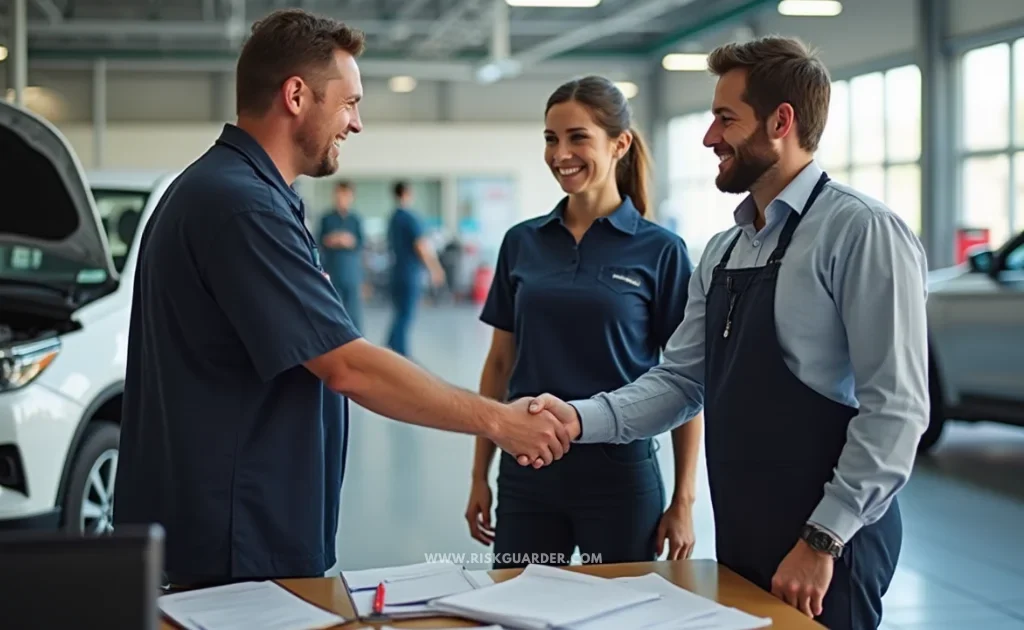Introduction: Navigating the Insurance Repair Maze
Picture this: your vehicle has just been involved in an unexpected accident. The immediate aftermath brings a whirlwind of emotions—stress, confusion, and uncertainty about the next steps. Amidst this chaos, understanding your insurance policy and managing the repair process can feel overwhelming. You’re not alone in this experience. Many find themselves entangled in the complexities of insurance claims and repair procedures, searching for a straightforward solution. This is where Direct Repair Programs (DRP) come into play, offering a streamlined and efficient pathway to ease your burden. In this guide, we’ll explore the intricacies of the direct repair programs insurance companies application, equipping you with the knowledge to navigate the repair process smoothly, save time and money, and ensure your vehicle is restored to its optimal condition with minimal hassle.
Understanding Direct Repair Programs (DRP)

What Are Direct Repair Programs?
Direct Repair Programs (DRPs) are collaborative arrangements between insurance providers and selected auto repair facilities. These partnerships are designed to accelerate the claims and repair processes, ensuring that policyholders receive prompt and high-quality repairs without the usual delays associated with traditional methods.
- Definition and Purpose
- DRPs involve alliances where insurance companies endorse specific repair shops to handle claims efficiently.
- The primary aim is to simplify the repair journey for policyholders by providing access to a trusted network of repair centers.
- Benefits for Policyholders
- Quicker Repairs: With a list of pre-approved shops, your vehicle can be assessed and fixed more rapidly.
- Quality Assurance: DRP-affiliated shops adhere to high standards, ensuring repairs are performed correctly and efficiently.
- Lower Out-of-Pocket Costs: Streamlined processes often lead to fewer unexpected expenses, offering financial relief.
How DRPs Collaborate with Insurance Companies
Grasping how DRPs function in tandem with insurance companies can help you fully utilize their advantages.
- Collaboration Mechanism
- Insurance firms establish agreements with selected repair shops, forming a reliable network.
- These shops undergo thorough evaluations to ensure they meet the insurer’s quality and service benchmarks.
- Streamlined Communication
- Direct channels between your insurer and the repair facility facilitate quicker information exchange.
- This synergy minimizes delays, ensuring your claim is processed and your vehicle is repaired promptly.
Key Terms and Concepts in DRP
Familiarizing yourself with essential DRP terminology can enhance your understanding and navigation of the repair process.
- Approved vs. Preferred Shops
- Approved Shops: These are repair facilities that have met the insurer’s basic criteria for participation in the DRP.
- Preferred Shops: A subset of approved shops that excel in service quality, often offering additional perks to policyholders.
- Warranty and Guarantee Terms
- DRP-affiliated repair shops typically provide warranties on their work, ensuring that repairs are dependable and long-lasting.
- Understanding these terms ensures you are aware of your rights and the extent of coverage post-repair.
The Application Process for Direct Repair Programs

Eligibility Criteria for DRP Membership
Before embarking on the application journey, it’s crucial to comprehend the eligibility requirements that both insurers and repair shops must satisfy.
- Insurance Company Requirements
- Minimum Coverage Levels: Insurers may mandate policyholders to maintain specific coverage levels to qualify for DRP benefits.
- Policyholder Eligibility: Factors such as claim history, vehicle type, and location can influence eligibility.
- Repair Shop Qualifications
- Certifications: Shops must hold relevant certifications (e.g., I-CAR, AAA) to demonstrate expertise and quality.
- Quality Standards: Adherence to industry standards in repair practices and customer service metrics is mandatory.
Step-by-Step Guide to Applying for a DRP
Navigating the application process is straightforward when broken down into manageable steps.
- Reach Out to Your Insurance Provider
- Begin the DRP application by contacting your insurer’s customer service or claims department.
- Express your interest in utilizing the DRP for your current or future claims.
- Provide Necessary Documentation
- Supply essential documents such as proof of insurance, vehicle details, and any relevant claim information.
- Make sure all paperwork is thorough and precise to prevent holdups in the application process.
- Select a Certified Repair Shop
- Choose from your insurer’s network of endorsed DRP partners.
- Consider factors like proximity, shop reputation, and available services when making your choice.
- Receive Approval and Confirmation
- Once your application is reviewed and approved, you’ll get confirmation of your DRP enrollment.
- The insurer will coordinate with the chosen repair shop to schedule your vehicle’s assessment and repair.
Common Challenges and How to Overcome Them
While DRPs are designed to simplify the repair process, you might encounter some hurdles along the way. Taking proactive steps can assist you in managing these obstacles efficiently.
- Handling Paperwork
- Tips for Organizing and Submitting Necessary Documents:
- Keep all relevant documents in a dedicated folder.
- Utilize digital copies where possible to ensure quick submission and easy access.
- Tips for Organizing and Submitting Necessary Documents:
- Opting for Non-DRP Repairs
- Understanding Exceptions and Alternatives:
- In certain cases, you might prefer a non-DRP repair shop.
- Discuss the reasons with your insurer and understand the implications on your claim and coverage.
- Understanding Exceptions and Alternatives:
Benefits of Joining a Direct Repair Program
Joining a DRP offers numerous advantages that go beyond mere convenience. Here’s how you can benefit from being part of a DRP.

Cost Savings and Financial Advantages
One of the most significant benefits of DRPs is the potential for cost savings, both immediate and long-term.
- Competitive Pricing Structures
- DRP-affiliated repair shops often provide services at negotiated rates, which can be more affordable than non-DRP options.
- Comparison Example:
- A minor dent repair might cost $300 through a DRP shop versus $450 at a non-DRP facility.
- Insurance Premium Discounts
- Some insurers offer premium discounts or incentives for policyholders who consistently use DRP services.
- Regular participation in DRPs can lead to overall savings on your insurance costs.
Enhanced Quality and Reliability
Quality is paramount when it comes to vehicle repairs, and DRPs ensure that your vehicle is in capable hands.
- Certified Repair Standards
- DRP shops are vetted for their expertise and commitment to high-quality repairs.
- Certifications from recognized bodies (e.g., I-CAR) ensure that technicians are trained in the latest repair techniques.
- Customer Satisfaction Metrics
- DRP networks often monitor customer feedback and satisfaction ratings.
- High satisfaction rates indicate reliable and trustworthy repair services within the network.
Time Efficiency and Convenience
Time is of the essence, especially when you’re without your vehicle. DRPs help minimize downtime through efficient processes.
- Faster Claim Processing
- Streamlined communication between insurers and repair shops accelerates the claim approval and repair scheduling.
- Quick processing means you can get back on the road sooner.
- Seamless Coordination
- Integrated services within DRPs reduce the likelihood of miscommunications and delays.
- Coordinated efforts ensure that every aspect of the repair process is handled promptly and professionally.
Choosing the Right Repair Shop within a DRP
Selecting the appropriate repair shop within a DRP network is crucial to ensure quality and satisfaction. Here’s how to make an informed decision.
Evaluating Repair Shop Credentials
Not all DRP-affiliated shops are created equal. Assessing their credentials ensures you receive top-notch service.
- Certifications and Accreditations
- Look for shops with certifications from reputable organizations like AAA or I-CAR.
- These certifications reflect a dedication to quality and ongoing education.
- Experience and Specializations
- Assess the shop’s experience, particularly with your vehicle’s make and model.
- Specialized repair capabilities can lead to more precise and efficient fixes.
Reading Reviews and Testimonials
Customer feedback is a valuable resource when choosing a repair shop.
- Customer Feedback Analysis
- Online reviews on platforms like Google, Yelp, and the Better Business Bureau provide insights into the shop’s performance.
- Notice consistent patterns in feedback, both positive and negative.
- Case Studies and Success Stories
- Look for documented examples of successful repairs and satisfied customers.
- Success stories can give you confidence in the shop’s abilities and customer service.
Comparing Services and Amenities
Beyond repairs, the additional services offered by a shop can enhance your overall experience.
- Additional Services Offered
- Amenities like loaner cars, shuttle services, and free Wi-Fi can add convenience during the repair period.
- Extended warranties on repairs provide extra assurance of quality.
- Facility Standards
- A clean, organized, and well-equipped facility reflects the shop’s professionalism and commitment to quality.
- Modern equipment ensures that repairs are performed efficiently and accurately.
Optimizing Your Insurance Claim with DRP
Maximizing the benefits of your DRP involves strategic actions that enhance your claim experience.
Effective Communication with Your Insurer and Repair Shop
Clear and consistent communication is key to a smooth repair process.
- Clear Documentation
- Maintain comprehensive records of all interactions, including emails, phone calls, and written correspondence.
- Keeping track of your communications ensures you have evidence in case of discrepancies.
- Regular Updates
- Stay in touch with both your insurer and the repair shop to receive timely updates on your claim and repair status.
- Proactive communication helps address any issues promptly, preventing delays.
Maximizing Coverage Benefits
Understanding and utilizing your insurance coverage effectively can lead to a more beneficial outcome.
- Understanding Your Policy
- Get to know the details of your insurance policy, including coverage limits and exclusions.
- Knowing what’s covered helps you avoid unexpected costs and ensures you receive all entitled benefits.
- Avoiding Common Pitfalls
- Tips to Prevent Denied Claims:
- Submit all required documentation accurately and on time.
- Follow your insurer’s guidelines for repairs and claim submissions.
- Tips to Prevent Denied Claims:
Post-Repair Inspection and Feedback
Ensuring the quality of repairs and providing feedback contributes to the overall improvement of DRP services.
- Quality Assurance Checks
- Inspect your vehicle thoroughly after repairs to ensure all work meets your expectations and industry standards.
- Don’t hesitate to request adjustments if something doesn’t seem right.
- Providing Constructive Feedback
- Share your experience with both the repair shop and your insurer.
- Constructive feedback helps improve services and assists other policyholders in making informed decisions.
Comparative Analysis: DRP vs. Traditional Repair Processes
Understanding the differences between DRPs and traditional repair methods can help you make informed decisions.
Cost Comparison
Evaluating the financial implications of DRPs versus traditional repairs highlights potential savings.
- DRP Pricing vs. Non-DRP Estimates Repair Type DRP Cost Non-DRP Cost Minor Dent Repair $300 $450 Engine Replacement $2,500 $3,200 Paint Job $1,200 $1,800
- Analysis:
- DRP shops often offer competitive pricing due to negotiated rates with insurers.
- These savings can accumulate, especially for more extensive repairs.
- Analysis:
Time Efficiency
Time saved during the repair process is another significant advantage of DRPs.
- Average Repair Times
- DRP: 3-5 days
- Traditional: 7-10 days
- Impact on Vehicle Availability:
- Faster repairs mean you spend less time without your vehicle, minimizing inconvenience.
Quality of Service
Ensuring high-quality repairs is paramount, and DRPs often excel in this area.
- Warranty and Guarantees
- DRP shops typically offer robust warranties on their repairs, providing peace of mind.
- Traditional shops may offer varying warranty terms, sometimes less comprehensive.
- Customer Satisfaction Rates
- DRP-affiliated shops often maintain high customer satisfaction rates due to standardized quality and efficient service.
- Traditional repair shops may have more variability in customer experiences.
Future Trends in Direct Repair Programs
The landscape of Direct Repair Programs is evolving, influenced by technological advancements and changing consumer expectations.
Technological Advancements
Innovation is driving the future of DRPs, making the repair process even more efficient and user-friendly.
- Digital Claim Processing
- The integration of AI and automation streamlines claim submissions and approvals.
- Policyholders can track their claims in real-time through online portals.
- Enhanced Communication Platforms
- Mobile apps and online platforms facilitate seamless communication between insurers, repair shops, and policyholders.
- These tools provide real-time updates, reducing uncertainty and enhancing transparency.
Expansion of DRP Networks
As the benefits of DRPs become more evident, their networks are expanding to include more insurers and repair shops.
- Growing Partnerships
- Increasing collaborations between insurance companies and repair shops broaden the DRP network, offering policyholders more options.
- Global DRP Models
- Adoption of DRP frameworks in international markets ensures that policyholders traveling abroad can access reliable repair services.
Sustainability and Eco-Friendly Repairs
Environmental considerations are becoming integral to DRPs, promoting sustainable repair practices.
- Green Repair Practices
- Incorporation of eco-friendly materials and methods reduces the environmental impact of vehicle repairs.
- Eco-Certifications for Repair Shops
- Shops with environmental certifications demonstrate a commitment to sustainability, appealing to eco-conscious policyholders.
Conclusion: Empowering Your Insurance Repair Experience
Direct Repair Programs revolutionize the way you handle vehicle repairs post-accident. By understanding the direct repair programs insurance companies application process, you can navigate the repair landscape with confidence, saving time and money while ensuring high-quality service. Embrace the advantages of DRPs to transform a stressful situation into a seamless and efficient experience. Take control of your insurance repairs today and enjoy the peace of mind that comes with being part of a trusted repair network.
Frequently Asked Questions (FAQ)
1. What is a Direct Repair Program in insurance?
A Direct Repair Program (DRP) is a partnership between insurance companies and approved auto repair shops to streamline the claims and repair process for policyholders.
2. How do I apply for a Direct Repair Program through my insurance company?
To apply for a DRP, contact your insurance provider, submit the required documentation, choose a certified repair shop from their network, and receive confirmation of your DRP enrollment.
3. Are there cost benefits to using a DRP-affiliated repair shop?
Yes, DRP-affiliated repair shops often offer competitive pricing, which can lead to significant cost savings compared to non-DRP repairs.
4. Can I choose any repair shop outside of the DRP network?
While you have the option to choose a non-DRP repair shop, using a DRP-affiliated shop can lead to faster repairs and a more streamlined claims process.
5. What should I do if I’m not satisfied with the repairs from a DRP shop?
If you’re unsatisfied with the repairs, contact your insurance provider to discuss your concerns and explore possible resolutions, which may include seeking a second opinion or using an alternative DRP shop.
Take Action Today!
Don’t let the stress of vehicle repairs weigh you down. Reach out to your insurance provider to learn more about their Direct Repair Program and experience a hassle-free repair process. Empower yourself with the knowledge and resources to ensure your vehicle is restored efficiently and effectively. Start your journey towards a smoother insurance repair experience now!






![[Company Name] Travel Insurance](https://www.riskguarder.com/wp-content/uploads/2025/03/Company-Name-Travel-Insurance-768x630.webp)